Biological Effects of Metal Nanoparticles, 1st ed. 2016
Auteurs : Egorova Elena Mikhailovna, Kubatiev Aslan Amirkhanovich, Schvets Vitaly Ivanovich

This book offers a comprehensive overview of recent studies conducted on the biological effects of metal nanoparticles. It also provides a solid theoretical foundation and various metal nanoparticle synthesis methods.
Part I reviews the main chemical methods used for synthesizing metal nanoparticles in a solution and describes original method of biochemical synthesis, as well as some special procedures developed specifically for studying the biological activity of nanoparticles.
Part II analyzes current literature on the effects of metal nanoparticles observed in microorganisms and addresses the influence of silver nanoparticles obtained by biochemical synthesis on biological objects on various organization levels, namely on microorganisms, acellular slim mold, unicellular alga, plant seeds and mammalian cells.
The last section explains the central problems common in studies on the biological effects of metal nanoparticles and outlines potential uses of this trend in bio-nanotechnologies.
This book is aimed at specialists, professors and students aspiring to expand their knowledge about the biological activities of metal nanoparticles and nanoparticle-containing materials.
Offers an up-to-date
overview of metal nanoparticles’ biological activities
Provides a theoretical
foundation and various metal nanoparticle synthesis methods
Outlines possible problems of studies on the biological effects of metal nanoparticles
Highlights various uses of metal nanoparticles in bio-nanotechnologies
Includes supplementary material: sn.pub/extras
Date de parution : 05-2016
Ouvrage de 292 p.
15.5x23.5 cm
Disponible chez l'éditeur (délai d'approvisionnement : 15 jours).
Prix indicatif 105,49 €
Ajouter au panier

